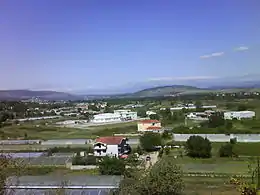Gabela, Čapljina
Gabela (Serbian Cyrillic: Габела) is a village in southern Bosnia and Herzegovina, 5 kilometres south of Čapljina and 4 kilometers from Metković, in Croatia. It is situated in the navigable lower course of the Neretva, off the major road linking the coast with the mountainous hinterland. The word Gabela comes from Arabic word for tax (al-qabala).


History
According to history, Gabela was first mentioned in a contract between the Serbian ruler Nemanja and the Republic of Ragusa as Drijeva (the old Serbo-Croatian word for ship or ferry). Up to the end of the 12th century it was called Drijevo and was an important centre for the trade between the Bosnian kings and Dubrovnik, in which goods were flowing from Dubrovnik and Venice: salt, oil, wine, fabrics, glass, weapons and luxury goods, and from the inside: wood, meet, corn, wool, honey and cheese, until it became a Dubrovnik colony known as Osobljane.
Drijeva rapidly became a port for slave trading, along with Brštanik, and this was sanctioned by law. This can be seen in the archives of Dubrovnik, where the Mercantum Narenti (Forum Narenti) is mentioned, and in the Statute of Dubrovnik of 1272, where in the sixth book there is a series of passages (42-52) dealing with the social status of slaves.
In the 14th century the Bosnian kings began to implement forceful measures against this "trade in human flesh on the Neretva" and under pressure from them in 1400 the Dubrovnik Senate banned the trade in human lives, and the transport of slaves in Ragusan ships in 1416 under the threat of six months imprisonment in the underground dungeons in Dubrovnik in the Rector's Palace in Dubrovnik, as well as a fine. Under the name Gabela (it. Gabella - "customs house") the town was mentioned in 1399.
The Turks occupied the town in 1529 and built the Sedislam Fortress on the right-hand bank of the Neretva. It became the center of the Gabela captany (organized before 1561). In 1537 Gabela becomes part of Nevesinje kadiluk.
In the middle of 17th century Ali-Pasha Cengic rebuilt and reinforced the fort (so called Novi grad). In 1693 it was conquered by the Venetians who repaired the Turkish buildings, especially in Novi Grad (the new town) and Derzelez fortress, but they destroyed these buildings again when the Turks attacked once more and recaptured from them in 1715. In 1718 the Turks themselves rebuilt part of the settlement.[1] As well as fragments of the walls and towers, the ruins of two churches are also still visible, as well as the "sultan's Mosque" (Careva džamija) which the Venetians converted into a church, St. Stephen's (Sveti Stjepan), and added stone sculptures of lions, the symbol of the Venetian Empire.
Until 1878 it was an important border town between Herzegovina and Dalmatia, but the role of Gabela as the fort was taken by the town of Pocitelj. Today Gabela is a village in Čapljina municipality in Bosnia-Herzegovina about 3 km from the border with Croatia on the right bank of the Neretva river, again an important point of transit, with a rail road passing through it.
Gabela Concentration Camp
Gabela camp was a concentration camp run by the Croatian Community of Herzeg-Bosnia and Croatian Defence Council. The camp consisted of detention facilities and a munitions warehouse. "Outside observers were not allowed to visit Gabela until August 1993. At this time the ICRC registered 1,100 inmates."[2]
Demographics
| Population of Gabela municipality | ||||||
| Year of census | 1991 | |||||
| Muslims | 32 (1.31%) | |||||
| Serbs | 324 (13.27%) | |||||
| Croats | 2,046 (83.85%) | |||||
| Yugoslavs | 24 (0.9876%) | |||||
| others and unknown | 14 (0.57%) | |||||
| total | 2,440 | |||||
Further reading
- Official results from the book: Ethnic composition of Bosnia-Herzegovina population, by municipalities and settlements, Zavod za statistiku Bosne i Hercegovine - Bilten no.234, Sarajevo 1991.
- Roberto Salinas Price, Homeric whispers: intimations of orthodoxy in the Iliad and Odyssey, Scylax Press (2006), ISBN 0-910865-11-6 on Google books.
See also
References
- Naklada Naprijed, The Croatian Adriatic Tourist Guide, pg. 318, Zagreb (1999), ISBN 953-178-097-8
- University of West England, Bristol, School of Humanities, Languages and Social Sciences - United Nations, (27 May 1994), Final report of the United Nations Commission of Experts established pursuant to security council resolution 780 (1992) Archived 2007-12-10 at the Wayback Machine
External links
| Wikimedia Commons has media related to Gabela. |

